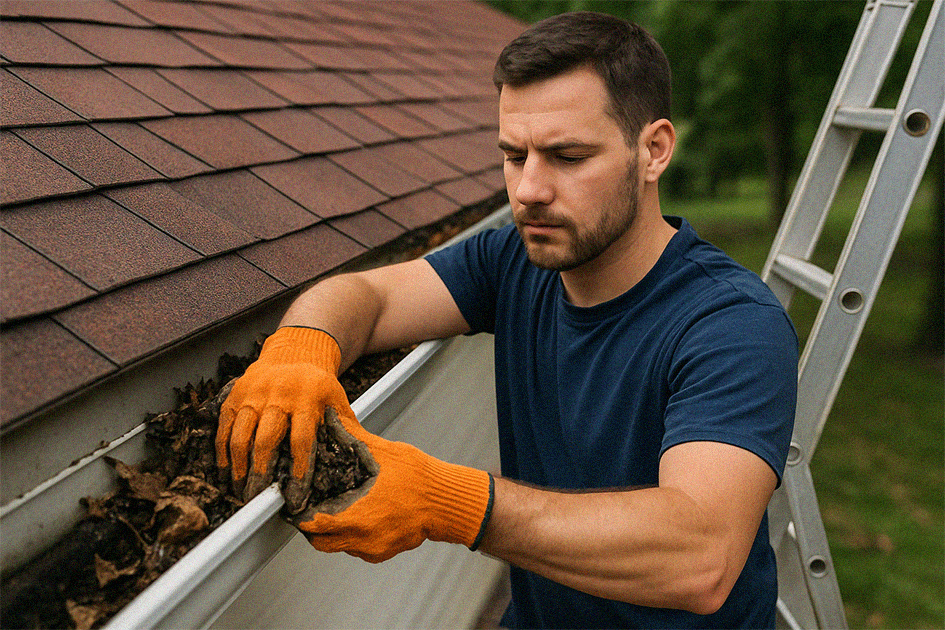
Choosing the right time to pressure wash your house can make a significant difference in the quality and longevity of results. While professional pressure washing can be done year-round in North Carolina's mild climate, certain times of year offer distinct advantages that smart homeowners leverage for optimal outcomes. Let's explore the best timing for your pressure washing needs and how to plan strategically for maximum impact.
The Ideal Times for Pressure Washing in North Carolina
Spring (Late March through May): THE OPTIMAL SEASON
Spring represents the absolute best time for pressure washing in North Carolina, combining ideal weather conditions with practical timing that prepares your home for the active outdoor season ahead. After winter but before heat, spring cleaning removes accumulated winter grime and salt residue while clearing away dirt before warm weather promotes biological growth. This timing prepares your exterior for summer activities while taking advantage of perfect temperatures—typically 60-75°F—that allow cleaning solutions to work effectively without rapid evaporation or freezing concerns.
Pollen season considerations require strategic scheduling. Early spring brings heavy pollen before late March, making late April or early May the sweet spot after peak pollen season passes. This timing removes pollen buildup before it chemically bonds with surfaces during the first rains, preventing the brown staining that pollen leaves when it sets.
Preparation benefits make spring pressure washing especially valuable. You're readying your home for spring gardening season when you'll spend time outdoors appreciating clean surfaces, preparing decks for outdoor entertaining season, timing perfectly for Mother's Day and graduation parties, and creating ideal pre-listing appearance if selling during the busy spring real estate market.

Weather conditions in North Carolina spring provide moderate temperatures, lower humidity than oppressive summer levels, consistent dry periods between rain events, and comfortable working conditions for thorough cleaning. Best spring timing: Late April or early May, after pollen season peaks but before summer humidity arrives.
Fall (September through October): STRONG SECOND CHOICE
Fall ranks as the second-best pressure washing season, offering excellent conditions while addressing summer's legacy of growth and grime. Summer cleanup removes mold and mildew that flourished during humid months, eliminates summer dust and accumulated grime, prepares your home for winter weather protection, and addresses biological growth before it sets in and becomes more difficult to remove after winter dormancy.
Holiday preparation makes fall cleaning particularly appealing—perfect timing before Thanksgiving and Christmas visitors, readying your home for holiday decorating that showcases clean exteriors, creating fresh appearance for family gatherings, and ensuring your home looks its best during the season of guests and celebrations.
Comfortable conditions mirror spring advantages with mild temperatures (typically 65-75°F), humidity lower than summer's oppressive levels, pleasant working weather, and good drying conditions. Prevention through fall cleaning removes growth before winter dormancy, prevents staining from setting in over months of cold weather, and protects surfaces before harsh winter conditions. Best fall timing: September or early October before temperatures drop significantly.
| Season | Best Months | Temperature Range | Advantages | Challenges | Ideal For |
|---|---|---|---|---|---|
| Spring | Late April-May | 60-75°F | Post-winter refresh, pre-summer prep, after pollen | Occasional rain | Annual cleaning, pre-sale prep |
| Fall | Sept-Oct | 65-75°F | Summer cleanup, pre-holiday, prevention | Leaves falling | Bi-annual cleaning, holiday prep |
| Summer | June, Aug | 75-90°F | Fast drying, flexible scheduling | Extreme heat, high humidity | Event preparation, maintenance |
| Winter | Nov, Feb-Mar | 40-60°F | Off-season availability, pricing | Cold limits, short days | Emergency only, mild days |
Summer (June through August): GOOD WITH CAVEATS
Summer offers advantages despite not being optimal. Quick drying from warm temperatures means surfaces dry fast, reducing waiting time between cleaning and sealing, minimizing moisture retention risks, and allowing faster project completion. Flexible scheduling benefits from longer daylight hours, more available appointment times, and good timing for event preparation like graduations and weddings.
Summer challenges require awareness and adaptation. Heat concerns mean very hot days cause solutions to dry too quickly reducing effectiveness, extreme heat creates uncomfortable working conditions for technicians, and scheduling may require early morning or evening appointments to avoid peak afternoon heat.
Higher humidity promotes faster regrowth of biological organisms, can affect drying times unpredictably, and creates more atmospheric moisture. Faster regrowth in warm, humid conditions means mold and mildew return more quickly, potentially requiring more frequent cleaning. Best summer timing: Early June before peak heat, or late August as temperatures moderate, with scheduling preference for early morning or evening during July's most intense heat.
Winter (November through February): POSSIBLE, CONDITIONS DEPENDENT
Winter cleaning works under specific circumstances when temperature, forecast, and need align appropriately. Temperature requirements are absolute—days must exceed 40°F minimum (ideally 50°F+), no freezing temperatures can appear in the 24-hour forecast before or after cleaning, and mild, sunny winter days provide the only acceptable windows.
Winter advantages include off-season benefits like greater availability, sometimes discounted pricing, less competition for appointments, and faster scheduling. Specific needs that justify winter cleaning include de-icing salt removal preventing corrosion, pre-holiday cleaning in November or December, pre-sale preparation that can't wait for spring, and immediate mold or mildew issues threatening health or property.
Winter challenges are substantial. Temperature limitations mean freezing damages wet surfaces, solutions work less effectively in cold, water can freeze in equipment creating malfunction, and uncomfortable conditions reduce working efficiency. Shorter days limit available work hours, require earlier scheduling, and bring weather that can change rapidly. Best winter timing: Mild days in November or late February/early March; strongly avoid December-January cold periods.
Weather Requirements for Pressure Washing
Regardless of season, successful pressure washing requires appropriate weather conditions that support effective cleaning and proper drying.
Temperature ideally falls between 50-80°F (optimal), with acceptable range of 40-90°F, avoiding anything below 40°F or above 95°F. Cold temperatures reduce cleaning solution effectiveness dramatically, freezing can damage wet surfaces and create ice hazards, and extreme heat causes rapid evaporation before cleaning action completes.
Forecast requirements include no rain for 24 hours before service allowing surfaces to dry, no rain for 24-48 hours after service letting cleaning solutions work fully, and dry conditions for 2-3 days if sealing follows cleaning. Rain before cleaning dilutes solutions and reduces effectiveness, post-cleaning rain can rinse away treatments prematurely or cause spotting, and sealing absolutely requires extended dry conditions.
Humidity optimally stays below 70%, remains acceptable at 70-80%, but becomes less ideal above 80%. Humidity affects drying time significantly, influences how cleaning solutions perform, and impacts biological regrowth rate after cleaning—high humidity post-cleaning promotes faster mold and mildew return.
Wind ideally provides light breeze (5-10 mph) aiding drying, remains acceptable when calm to moderate (0-15 mph), but should be avoided when high winds (20+ mph) occur. Light wind helps surfaces dry, but excessive wind causes overspray issues affecting neighbors and vehicles while blowing debris onto fresh-cleaned surfaces.
Timing Based on Your Specific Goals
Different cleaning objectives demand different optimal timing that aligns with your specific needs and priorities.
Pre-event cleaning for weddings, graduations, or parties should be scheduled 1-2 weeks before the event, allowing time for any necessary touch-ups, ensuring surfaces are fully dried and settled, and giving you bandwidth to arrange other event preparations without last-minute stress.
Pre-sale preparation when listing your home benefits from cleaning 1-2 weeks before listing, photographing after cleaning captures maximum visual impact for online listings, touching up right before showings if needed maintains perfection, and considering spring or fall timing maximizes curb appeal during prime home-showing conditions.
Routine maintenance through annual or bi-annual cleaning establishes spring (April/May) as primary comprehensive cleaning, adds fall (September/October) as secondary refresh for those wanting year-round perfection, implements both cleanings if you prioritize consistent appearance, and maintains once annually minimum for surface protection and longevity.
Problem-focused cleaning addresses mold, mildew, or staining as soon as possible when issues appear—don't wait for the "perfect" season. Immediate attention prevents worsening and deeper penetration. Work within weather constraints but prioritize treatment over waiting for ideal conditions.
Regional Timing Considerations for North Carolina
North Carolina's geographic diversity creates regional variation in optimal timing across the state's different climate zones.
Piedmont Region (Statesville, Mooresville, Charlotte area) ideally schedules spring cleaning mid-April to mid-May after pollen subsides, fall cleaning September to mid-October, summer alternatives in early June or late August, and winter opportunities in November and late February on mild days. Special considerations include managing heavy pollen season from late March to mid-April, humid summers promoting rapid growth, and mild winters allowing year-round cleaning with proper scheduling.
Mountain Region (Hickory, Taylorsville, Boone area) shifts timing later for spring (late April to late May) due to cooler temperatures, earlier for fall (September to early October) as cold arrives sooner, uses summer (June through August) as primary season, and finds winter very limited with cleaning only possible on the warmest days. Special considerations include overall cooler temperatures throughout the year, shorter warm season for cleaning, more rainfall in mountain areas, and earlier fall temperature drops.
How to Plan Your Pressure Washing Schedule
Strategic planning ensures you capture optimal conditions while meeting your specific needs.
For annual cleaning, late April or early May represents the best single-clean timing, removing winter and early spring grime comprehensively, scheduling after major pollen season passes, preparing surfaces for summer activities, taking advantage of good weather conditions, and protecting your home for 8-12 months from that cleaning.
For bi-annual cleaning, implement spring clean in late April or early May, followed by fall clean in September or early October, providing comprehensive year-round protection, handling seasonal buildup before it becomes embedded, keeping your home consistently beautiful, and delivering worthwhile investment particularly in North Carolina's humid climate.
Creating your personal schedule requires marking your calendar for ideal months within your chosen strategy, booking early for popular spring and fall appointment slots (2-4 weeks advance recommended), watching forecasts in days before scheduled service, maintaining flexibility with specific dates within your target month, and planning around events if hosting guests or selling your home.
What If You Can't Wait for the "Perfect" Time?
Life circumstances don't always align with optimal pressure washing seasons. When you need service at non-ideal times, smart strategies minimize compromises.
Work with professionals who have experience operating in various conditions and know how to adapt techniques for less-than-perfect weather. Watch forecasts closely to identify the best available weather window within your constrained timeframe. Adjust expectations understanding results may vary slightly in extreme weather but can still be quite good. Consider partial service cleaning the most critical areas immediately while scheduling complete service for better conditions later. Emergency situations involving mold, mildew, or pre-sale needs often can't wait—professionals can accommodate urgent requirements despite timing challenges.
Ready to Schedule Your Pressure Washing?
For most North Carolina homeowners, the best single cleaning occurs in late April or early May, while optimal bi-annual service targets late April/early May plus September/early October. Acceptable cleaning can happen anytime temperatures fall between 40-90°F with no rain forecasted, but strongly avoid periods of freezing weather, heavy rain, or extreme heat above 95°F.
Remember: the best time to pressure wash is when your home needs it. While optimal timing helps maximize results and longevity, professional pressure washing delivers excellent outcomes year-round when weather permits. Don't let pursuit of perfection delay necessary maintenance.
Contact Exterior Shine at (704) 980-9859 to discuss ideal timing for your pressure washing project. We'll consider your goals, the current season, upcoming weather patterns, and our availability to find the perfect window for transforming your home's exterior. Let's schedule your service strategically for optimal results!

Scott Deviney
Co-Founder & Customer Relations
Scott handles all aspects of customer service and ensures that every client receives the personalized attention they deserve. With a background in business management and a genuine passion for helping people, he's built Exterior Shine's reputation for outstanding customer care.
